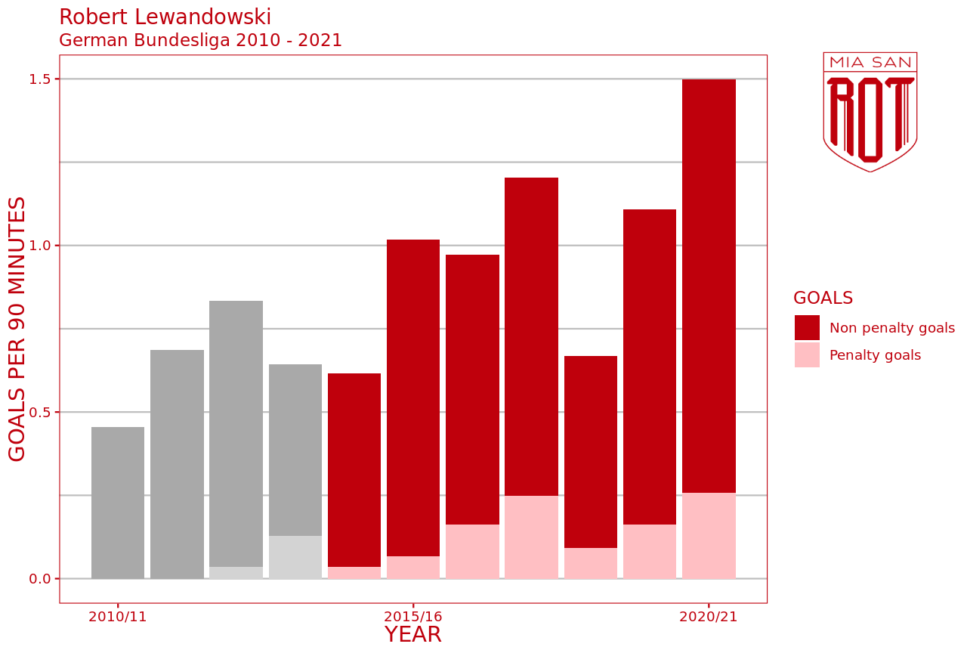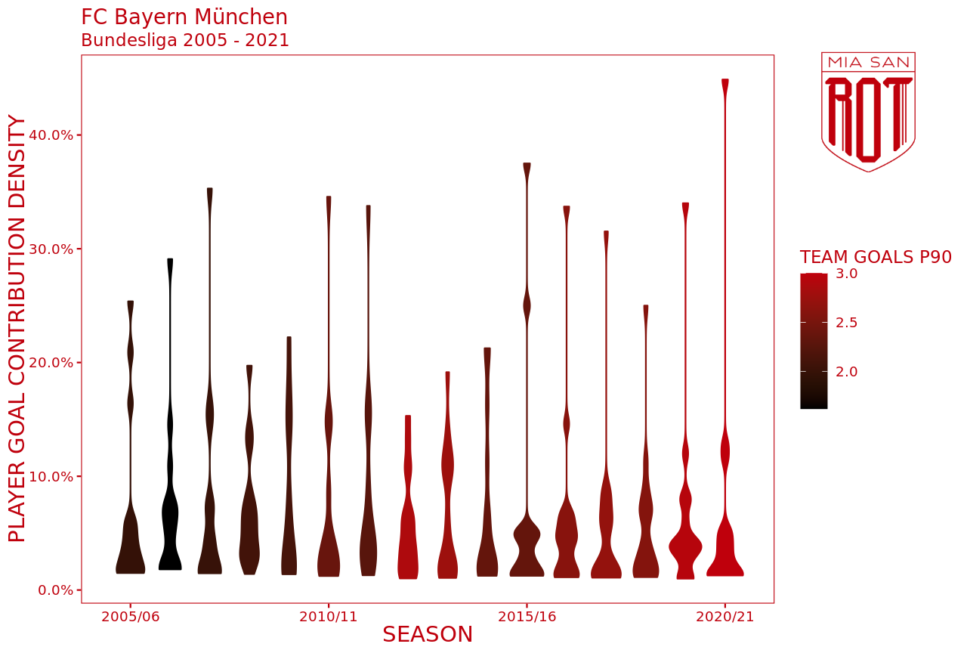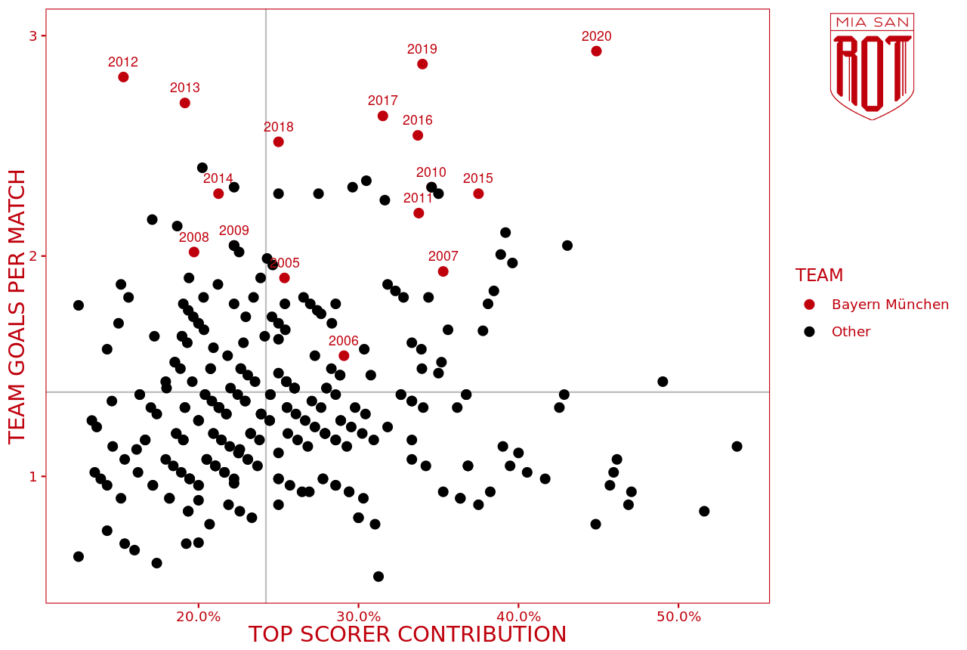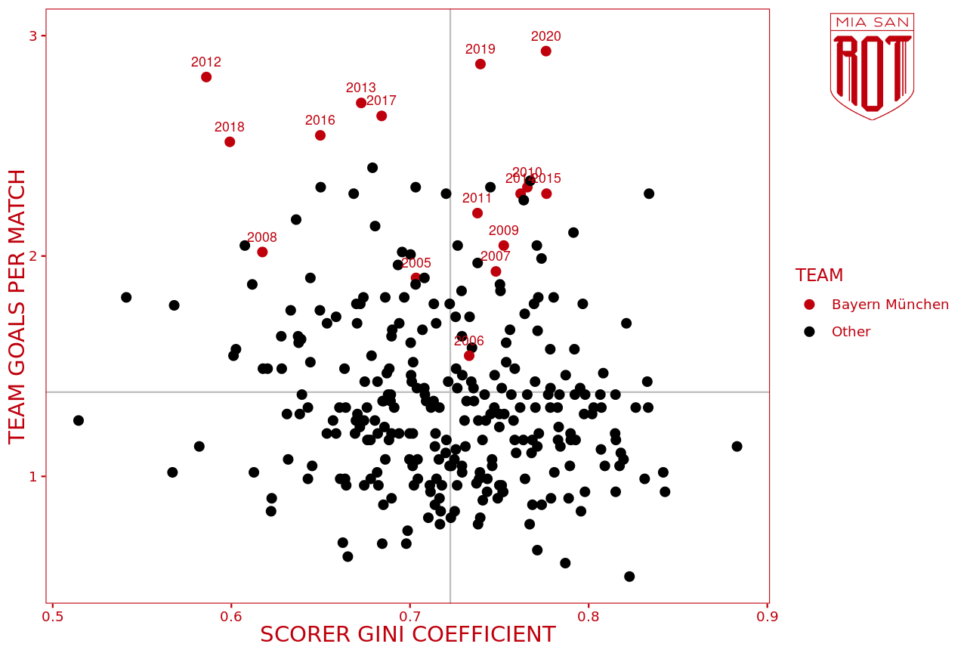How much are FC Bayern depending on Robert Lewandowski?
The reigning FIFA world best player has a Bundesliga season the likes of which has not been seen for a long time. With Gerd Müller’s goal “record for eternity” in sight (see also player of the month of March: Robert Lewandowski), he not only leads the Bundesliga goal-scoring ranking by a wide margin, but has now also far outstripped his most prominent pursuers in Europe.
A look at Lewandowski’s goal scoring output over time not only reveals that his goal rate seems to have been steadily increasing, but also shows the Pole’s impressive consistency. His worst season in the last six years (2018/19) was not only enough to secure his team a 7th consecutive championship, but also the Bundesliga goalscoring crown for himself.

Robert Lewandowski has greatly benefited from the fact that he has managed to avoid major injury complications throughout his career. The biggest threat to his goalscoring records always seemed to be the intention of his respective coach to save his best striker for the next important game. According to transfermarkt.de, Lewandowski has missed only 133 days due to injury during his time in the Bundesliga. He has never played less than 88% of a Bundesliga season.
This has made it almost impossible for the FC Bayern management to sign a second striker of a similar calibre, let alone keep him happy in the long term. So, for better or worse, FC Bayern has found themselves dependent on their indestructible goal-scoring ace.
Bayern’s recent dependence on a strong striker
This dependence can be seen very clearly in the following violin diagram. Here you can see the distribution of goals scored among the respective scorers of FC Bayern in the Bundesliga. The wider the “violin” at one point, the more players are in that area. The frequent bulge around the 5% mark thus shows an accumulation of players who were responsible for about 5% of the total goals scored.

For example, the diagram shows that in the 2012/13 treble winning season, no individual player alone was responsible for more than 16% of the goals scored in the Bundesliga (Mario Mandžukić scored 15 of the 98 goals, and there were 17 different scorers in all).
Apart from his first season in the red jersey, as well as the somewhat weaker 2018/19 season, Lewandowski always scored at least 31% of all Bayern goals. In the current season, he has even scored 45%.
But does he also score the “important goals”?
The what-if question of how Bayern would have finished without Lewandowski cannot be answered. The unknowns surrounding his possible replacement, the reactions of the FC Bayern management etc. are too great. Nevertheless, in order to be able to provide a rough indication of the actual impact of a player, it is at least possible to examine the respective situation in which a goal was scored. If a striker only ever scores the fourth goal in his team’s 4-0 victories, his actual impact is probably limited. If we look at Bayern’s last seasons and compare them with a hypothetical scenario in which Lewandowski had not scored any of his 197 goals, Bayern lose an average of 12 points per season, and even 20 of the current 61 points in the ongoing season. The fact that despite Lewandowski’s large share of goals Bayern would have dropped only about 16% of the points on average can probably be attributed to the unparalleled dominance of the record champions.
Nevertheless, the figures presented suggest that Lewandowski has played a not insignificant part in the club’s overall success in recent years. The question remains as to whether the dependence on a single striker is an unusual occurrence in the larger context of the Bundesliga. So let’s consult other striker-club combinations in the Bundesliga.
Cross comparison with other Bundesliga clubs

In order to put the respective striker’s contribution into perspective, the above graph shows the team’s goals scored per game on the vertical axis. As before, the horizontal axis shows the share of the top scorer in the total goals scored by the team. Each point represents one season of a Bundesliga club. In contrast to the chart shown earlier, the focus here is only on the respective top scorer.
To put it simply, the upper right hand quadrant contains all clubs that score an above-average number of goals and are heavily dependent on a single striker. In the lower right hand quadrant, the dependency is similarly high, but the club could not score as many goals overall. In the upper left hand quadrant are the clubs that score a lot of goals and are not dependent on a single striker.
In this type of chart, the most exciting information is usually found at the outer limits of the quadrants and thus in the extreme cases. The 2012/13 and 2020/21 seasons of FC Bayern catch the eye, and not only because of their colour highlighting.
The different faces of FC Bayern
The 2012/13 treble winning season and also the first season under Pep Guardiola in 2013/14 stand out due to a very low dependence on a single striker with an outstanding goal rate. Mario Mandžukić increased his involvement in goals from 15% in 2012/13 to 19% from in 2013/14. At the same time, however, five other players scored at least 10% of Bayern’s goals in 2013/14 (Thomas Müller, Arjen Robben, Claudio Pizarro, Franck Ribéry and Mario Götze). In the entire period under review, there were only two other clubs that managed to have at least six players with at least 10% of the goals (Mainz 2016 and Nürnberg 2012).
The current 2020/21 season represents the opposite extreme. FC Bayern’s overall goal rate is in similarly elevated spheres (and the club is well on the way to breaking the all time Bundesliga goal record), but the contribution of their top scorer is immeasurably higher. Strikers with even higher shares of their club’s goals can only be found at a few clubs in the lower right hand quadrant. The only two strikers who were able to break the 50% mark here were Papiss Demba Cissé in 2010 for SC Freiburg (22 out of 41 goals) and Theofanis Gekas in the same season for Eintracht Frankfurt (16 out of 31 goals).
While this way of looking at things lends itself to telling some exciting stories, some context is lost. For example, a hypothetical situation in which two players each score 50% of a club’s goals is presented in the same way as a situation in which one player scores 50% of the goals but the other 50% are shared among a number of teammates. In order to be able to look at these cases more closely, the following chart introduces another metric: the Gini coefficient.
Inequality in the distribution of goals

The Gini coefficient is usually used in economics to show inequalities, for example in a country’s income distribution in its population. The coefficient takes on a value of 0 if there is absolute equal distribution (in our example: every player scores the same number of goals). At the other end of the spectrum, if a single player scored 100% of the goals, the coefficient would show a value of 1. Even if the application here does not meet all the basic conditions (for example, it is illogical to assume that the goalkeeper would have to score the same number of goals as everyone else for a Gini coefficient for 0 to occur), it still produces an interesting result.
For example, Bayern’s 2018/19 season, which so far only stood out due to Lewandowski’s rather low goal quota, also jumps out because it saw a total of 18 different goal scorers for FC Bayern. Only two times have there been more goal scorers for a single club in a single season in the period under review. Werder Bremen, for example, had 20 different goal scorers in 2007/08.
The aforementioned 2010/11 season of SC Freiburg must also be mentioned here again. With a Gini coefficient of 0.88 and only seven different goal scorers, it shows the opposite extreme of the spectrum.
Borussia Mönchengladbach had the lowest Gini coefficient in the 2012/13 season. With 17 different goal scorers and two top scorers in Luuk de Jong and Patrick Herrmann, they achieved a value of only 0.51.
Conclusion
FC Bayern’s goal scoring record of the 2020/21 season is characterised by a strong Robert Lewandowski. Even in a cross-comparison with other Bundesliga clubs, there have been few comparable cases in the recent past in which a striker has scored such a high proportion of his club’s goals.
However, the fact that a team’s only regular striker scores a lot of goals should not surprise anyone. So to what extent this dominance actually indicates a dependence on a particular player is something FC Bayern will certainly find out in the coming weeks, as Lewandowski is likely to miss playing for up to four weeks due to injury.
The hope remains that Lewandowski’s absence will not affect the club’s overall goal output, but only its Gini coefficient.









